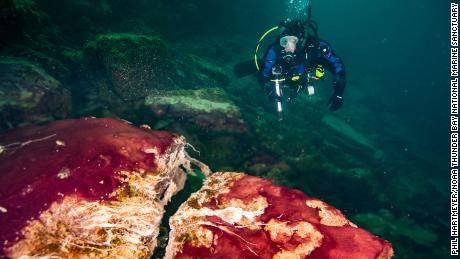Sign up for CNN's Wonder Theory science newsletter. Explore the universe with news on fascinating discoveries, scientific advancements and more .
(CNN) Earth hasn't always experienced the 24-hour day we're so familiar with now. In fact, the way the world turns not only determines the length of our day, but it could have contributed to an influx of oxygen on early Earth that helped life to flourish, according to new research.
Researchers studying a unique environment in Michigan's Lake Huron used it to effectively look back at ancient Earth and how changing day length could have impacted the earliest forms of life that existed: tiny organisms called cyanobacteria.
Also called blue-green algae, cyanobacteria evolved more than 2.4 billion years ago, and they were churning out oxygen when Earth was still pretty inhospitable. Scientists have struggled to explain why it took so long for Earth's oxygen levels to rise so gradually over almost 2 billion years -- until now.
Cyanobacteria doesn't have a great reputation these days because it's associated with toxic algae blooms in Lake Erie and other bodies of water. But this bacteria has been around longer than any other life form on Earth, and it was the first to convert light into energy through photosynthesis -- and release oxygen as a byproduct.
Researchers began to wonder how an increasing day length on early Earth might have allowed cyanobacteria to create more oxygen and lead to a diversity in animal life.
Read More
"When the Earth-Moon system formed, days were much shorter, possibly even as short as six hours," said study coauthor Brian Arbic, a physical oceanographer at the University of Michigan, in a statement. "Could this mean that changing daylength would have impacted photosynthesis over Earth's history?" When the moon became the Earth's satellite, the tug of the moon's gravity slowed down the rotation rate of our planet, leading to longer days. More sunlit hours would then have a positive effect on photosynthetic activity of cyanobacteria. Answers in a sinkhole Beneath Lake Huron is a bedrock formed from ancient seas that once covered the North American continent. This bedrock includes limestone, dolomite and gypsum, and over time, groundwater has dissolved some of it. This has formed cracks and caves, both of which have created submerged sinkholes. A scuba diver is shown observing the purple, white and green microbes covering rocks in Lake Huron's Middle Island Sinkhole. {"@context": "http://schema.org","@type": "ImageObject","name": "A scuba diver is shown observing the purple, white and green microbes covering rocks in Lake Huron's Middle Island Sinkhole.","description": "A scuba diver is shown observing the purple, white and green microbes covering rocks in Lake Huron's Middle Island Sinkhole.","url": "//cdn.cnn.com/cnnnext/dam/assets/210802181524-03-cyanobacteria-microbial-mats-large-169.jpg"} The submerged Middle Island Sinkhole in Lake Huron is where cold groundwater rich in sulfur and poor in oxygen seeps out of the lake bottom. While most plant and animal life avoid this area, microbes have found a home in this extreme environment 80 feet (24.4 meters) below the water's surface. The brightly colored bacteria form colonies called microbial mats, and they are the perfect analog for researchers wanting to study similar colonies that once existed on land and the seafloor billions of years ago. New find shows animal life may have existed millions of years before previously thought Today, two types of cyanobacteria form competing colonies here. One is a purple cyanobacteria that produces oxygen, while the other is a white bacteria that generates energy with the help of sulfur. The sulfur-fueled bacteria lie on top of the cyanobacteria from dusk until dawn, which blocks their access to sunlight. But once the sun emerges, the top bacteria colony moves down and allows the purple cyanobacteria to start the photosynthetic process to produce oxygen. "However, it takes a few hours before they really get going, there is a long lag in the morning. The cyanobacteria are rather late risers than morning persons, it seems," said study author Judith Klatt, a geomicrobiologist at the Max Planck Institute for Marine Microbiology in Germany, in a statement. Space dust reveals clues about Earth's early atmosphere "I realized that daylength and oxygen release from microbial mats are related by a very basic and fundamental concept: During short days, there is less time for gradients to develop and thus less oxygen can escape the mats," Klatt said. By modeling the link between sunlight and oxygen production, Klatt and her colleagues discovered that the release of oxygen during two 12-hour days on early Earth would not match that of a 24-hour day. The study team's findings showed a direct link between day length and how much oxygen can be released by microbes. Small hills and "fingers" in the mats of the sinkhole are caused by gases bubbling up beneath them. {"@context": "http://schema.org","@type": "ImageObject","name": "Small hills and "fingers" in the mats of the sinkhole are caused by gases bubbling up beneath them. ","description": "Small hills and "fingers" in the mats of the sinkhole are caused by gases bubbling up beneath them. ","url": "//cdn.cnn.com/cnnnext/dam/assets/210802181513-02-cyanobacteria-microbial-mats-large-169.jpg"} "Simply speaking, there is just less time for the oxygen to leave the mat in shorter days," Klatt said. This suggests that two great jumps in oxygen on Earth, including the Great Oxidation Event more than 2 billion years ago and the Neoproterozoic Oxygenation Event between 800 and 540 million years ago, could both be connected to longer days on Earth. The study published Monday in the journal Nature Geoscience .

